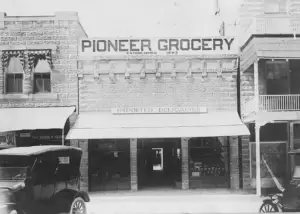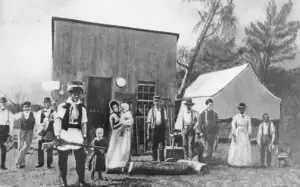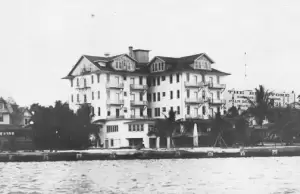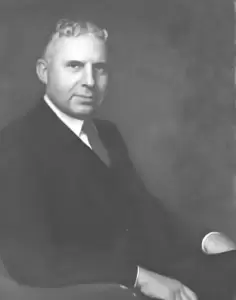Goods and Services: Business

According to Daisy Butler Lyman, who arrived on Lake Worth in 1894, Henry Flagler needed to move his workmen from their tents on the hotel grounds, so he sold them lots for about $50.00 a piece on and near Clematis Avenue. The first lot sold in the new town of West Palm Beach was to the Burkhardt brothers. They moved their wood and tent store from the grounds of the Royal Poinciana Hotel, ferried it across the lake on a barge, and settled in at 207 Clematis Avenue with a new name: “Pioneer Grocery.”

The little town spread quickly during the first few years, providing goods and services in demand by the residents as well as the hotel guests. Hotels also multiplied on the west side of the lake, although they were not as grand as in Palm Beach. In 1906 rooms could be rented for about $2.00 per night in one of 15 establishments. The 74-room Hotel Salt Air was built in 1913 by Mr. and Mrs. W. A. Weihe, at Narcissus and Datura. The site is now occupied by the Meyer Amphitheater.

The first bank in West Palm Beach actually started in Palm Beach. In 1893 Dade County State Bank was opened by Elisha Dimick and Edmund M. and John H. Brelsford, with Dimick as president. The building was moved to the corner of Clematis and Olive in 1897, and renamed Pioneer Bank when Palm Beach County was established in 1909. The building has since been moved to Flagler Drive and after many uses, it currently houses the Palm Beach High School Museum.
Another bank was opened in Palm Beach in 1909—the Bank of Palm Beach—by brothers Augustus P. “Gus” and James Rembert “J.R.” Anthony. In 1895 Gus Anthony had seen the promise in West Palm Beach and moved his men’s haberdashery (clothing store) from Titusville. It started as a counter business in the post office in the Palm Hotel lobby, and then moved next door to the corner of Clematis and Narcissus. Today, Anthony’s is the second oldest business in Palm Beach County. Anthony Brothers popularized the look that became the height of men’s fashion in Palm Beach: a navy sport coat, white pants, white shoes, and a straw boater. Younger brother Emile DuBose “E. D.” Anthony came to West Palm Beach in 1896 so his brothers could go into banking, and oversaw 12 stores from 1914 to 1925.
In 1900 the population of West Palm Beach reached 564 persons. Until then, the Free Reading Room, or library, had been available in the Union Congregational Church at Datura Street and Olive Avenue. Commodore Charles John Clarke then donated the two-story Palm Beach Yacht Club building for the library. Donations, including $100.00 from Henry Flagler, paid for a barge to move the building to City Park, on the lakefront at Clematis Avenue.
Anthony's
Emile DuBose Anthony, Sr., younger brother of A.P. “Gus” and James R. Anthony, took over most of the responsibilities of running Anthony’s to let his brothers spend more time with their banking businesses. Emile Sr. died in 1965 and his sons, Marvin Pope “Ham” and Emile, Jr. took over the business.
In 1962 Emile DuBose “E. D.” Anthony recalled the family business after he arrived in 1896:
The only partition in that store was the post office boxes in the same room. And we had our newsstand and our jewelry business in there with the post office in a 25-by-60-foot store. We added to it, and then I came down here …We got our papers from Jacksonville and they got here at 9:05 pm. And we met those trains, and the fella that could get down to town to Narcissus Street first, sold the papers. And I got there. It was a bicycle race in those days and believe me, I came up Datura full speed ahead. Everything—all the delivery in this part of the world—was on bicycles, baskets in front of the bicycles.


